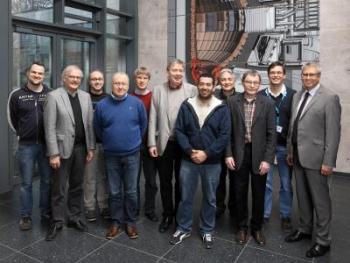Feb 14 2014
Forschungszentrum Jülich will lead a consortium of European partners to design a measuring system for the fusion experiment ITER. The facility is currently under construction in Cadarache in the south of France as part of a major international cooperation.
The consortium signed a Framework Partnership Agreement with the European Union's Joint Undertaking for ITER and the Development of Fusion Energy (F4E) to develop the ITER core plasma Charge Exchange Recombination Spectroscopy (CXRS) diagnostic. This measuring system will help determine the composition and temperature of the plasma in the vacuum vessel. The Framework Partnership Agreement runs for four years with an F4E contribution of 4.9 million euros.
 This shows Jülich plasma physicists in front of a drawing of a cross section of the ITER vacuum chamber. Credit: Forschungszentrum Jülich
This shows Jülich plasma physicists in front of a drawing of a cross section of the ITER vacuum chamber. Credit: Forschungszentrum Jülich
ITER is the next major step in international fusion research. F4E is responsible for providing the European contribution to ITER, which is scheduled to go into operation in the early 2020's and demonstrate the feasibility of fusion energy on a power-plant scale for the first time ever. The fusion of atomic nuclei will be used to generate energy. Similar processes occur inside the sun. If they can be controlled here on Earth, then we would have access to a safe and practically inexhaustible source of energy.
Once designed by the consortium, the core plasma CXRS system will be procured by F4E and assembled into a port plug, to be installed in an inset at the upper edge of the vacuum vessel. The consortium gained a significant knowledge related to this diagnostic through R&D tasks funded in the past years by the European Fusion Development Association (EFDA) and by the Federal Ministry of Education and Research (BMBF). In particular, deployment of such a system under the extreme conditions that will be encountered in ITER necessitates complex development work and tests. Indeed, temperatures exceeding 100 million degrees Celsius are expected within the vacuum vessel and the associated plasma radiation, neutron flux, and electromagnetic forces all impact significantly on the design choices for components. In addition, maintenance and repairs are usually only possible using remote-controlled tools or robots.
The CXRS diagnostic views a region of the ITER plasma illuminated by a high-energy beam of neutral hydrogen particles injected into the plasma by a companion device being constructed by ITER's Indian partners. Collisions with particles in the fusion plasma produce visible light. Its wavelength and spatial distribution allow conclusions to be drawn on various properties of the plasma. The measurements provide information that is crucial for sustaining the fusion reaction. The density of helium, in particular, is recorded. Helium is formed during the fusion reaction and must be removed from the combustion chamber if the fusion fire is to be kept alight. Other important parameters such as the concentration, temperature and velocity of different plasma species can be determined using the diagnostic.
The design of the CXRS diagnostic device is being performed, in particular, by physicists and engineers from the Jülich Institute of Energy and Climate Research (IEK-4) and by their colleagues at Jülich's Central Institute of Engineering, Electronics and Analytics (ZEA-1) as well as by their European partners (members of the consortium) including Karlsruhe Institute of Technology (KIT), universities of technology in Budapest (BME) and Eindhoven (TU/e), the Dutch Institute for Fundamental Energy Research (DIFFER), and CCFE in the UK. Contributing third parties include the Spanish CIEMAT centre and the Hungarian Wigner-RCP institute.